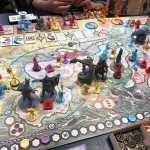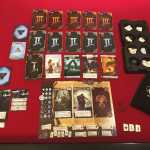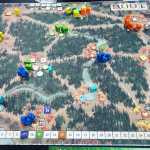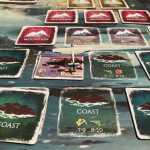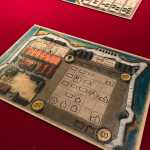Review: Fireball Island: Curse of Vul-Kar

Ahhh, Fireball Island, along with Omega Virus, the game I look fondly upon playing during my youth at friends' houses. Nostalgia runs deep with this one. When I heard that Rob Daviau and Restoration Games were reviving this old 1986 gem, not with just a reprint, but a completely new version, I was pretty stoked. There were many days where I played this as a young kid, excited to flick a fireball at my opponents and watch them come crashing down the volcano.
One downside of the old version is that it almost always ends up with a mad rush to the dock at the end, with everyone basically hopscotching each other and hoping they get the last draw to make it first. It's pretty high in RNG, and leaves much to be desired past nostalgia (and getting to shoot fireball marbles, which, let's be honest, who doesn't like that).
The new version has quite a lot more going for it. Included in this review is The Last Adventurer and Crouching Tiger, Hidden Bees! expansions, since they're really necessary to make this game shine. The base game feels pretty limited without those expansions. I've left off Treasure Trove and Wreck of the Crimson Cutlass, since those add a large amount of new game beyond this review.
Gameplay
The new version has a large change in its core mechanics - instead of rolling a die, this time you have a hand size of 2, and pick a card to play. Most cards also allow more movement than a 1d6 of the original, offering up to 12 movement and a new "second" action that lets you flick fireballs and snakes, roll a giant boulder, or even bounce a tiger onto an opponent. This means the chaos - and direct interaction with others - is elevated in this game, and you'll be doing a lot of attacking your opponents as you move toward others. You also often get to manipulate the terrain on cards, turning either Vul-Kar himself (with his three mouth-holes of fire) or the trees, which allow you to direct the flow of fireball traffic.

There's also the bees (oh God the bees), where you take a cup of a crap-ton of bees and dump them all down Vul-Kar as they scatter across the board. Have one of these touching you when they stop and you get a sting, which halves your movement next time. Annoying? Yep! Just like bees! How quaint. Rounding out our annoying vermin on the board setup are the snakes, which can be flicked by various cards, and if you get bit, your next turn is just drawing the top card of the deck and doing it like you're some hypnotized man-cobra.

Added to that aggression is when you hit another player successfully, you get to steal one of their treasures (their choice). This can mean that it's not always the best move to hit the easiest player, but instead sometimes opting for the harder shot can yield more rewards. Downside? If you hit yourself (or shoot a marble off the island), you lose a treasure. Also, getting hit means you get a souvenir card, which are generally pretty great, so it's not all bad for the toasted. Flicking is pretty limited here as you can only use your finger (no thumb or windups), so unless you're being really cavalier with your hot flaming ball, you should be fine on most shots. The board has a nice slope for you to pickup some...secondary casualties...on the fireball's way down too. And good old caves to randomly teleport to other spots on the map.
The endgame is new - in this version, endgame is triggered when someone has all three colors of snapshots (red/blue/yellow, more on them later) and moves on the "hellopad" space (awesomely named "hello-copter"), or we hit Max Cataclysm. Yes, Max Cataclysm. See, there are specific cards in the deck called "Cataclysm" cards that allow you to drop all the fireballs stored in the "Scar" (a holding pen) down Vul-Kar's...head?...and onto the board. Each of these get placed on a tracker that, for every 3 cards, will add a new fireball to that Scar. Once that's happened 3 times, the endgame triggers.
In the endgame, you have two turns to scramble to the hello-copter, or all your snapshots are worth zilch. Zero. Selfies don't matter if you can't share them! This creates a crazy scramble once someone triggers the end, where everyone is trying to get to that hellopad before all their hard work gets cooked. Oh, and you're still doing things here, so as you are running like mad, you're also firing fireballs and snakes and everything else at your opponents to prevent them from getting off the infernal island.
So play becomes a nice tension between "look at all the pretty things I can grab" and "Oh God I need to get off of here NOW!". Which, of course, causes hilarity to ensue when someone gets trapped on a bridge, only for their neighbor to send them plummeting to their end with a well-timed Vul-Kar drop. This creates a good framing around gameplay time without letting the game drag.
Scoring

Unlike the original, where the focus is primarily the jewel at the top of the volcano, Curse of Vul-Kar adds a whole bunch more things for you to grab. First off are the treasures, scattered all across the island, in three different colors. Getting more of the same color multiplies your points, so you'll quickly be trying to optimize your path to get all of one set. They're randomly placed, so that may work for you, or you may find it pointless. Who knows!
The Heart of Vul-Kar is a whopping 7 points, but if anyone walks past your spot, they steal it. This means you're a bit of a path target with it. The heart is conspicuously placed near the start, except between two bridges, which stop you flat if you walk on them. Meaning what seems like one turn ends up three. And those bridges? Well, they're easy shots for fireballs running beneath them to send you to a waterslide of doom. Doooooom.
If you're the lucky one to be the first off the island, you get a penny! Okay, so this penny makes you even more lucky, as it's 6 points (not to mention you're likely banking from being first off as well). I will note the penny looks like one of those flattened pennies you get from those vending machines at the shady side of a run-down theme park. So I'm a bit skeptical of its long-term luck value. But hey, 6 points!

And snapshots. Let's talk about snapshots. These babies are photos of your lovely guideless journey across the serene peace of the island...ok, not really. They're a pain to get, and spread across the entire board. You want three - one of each color. Each is worth five alone, but getting all three means you can control the endgame, which is huge in this game as it lets you dictate everyone else's plan. Getting these guys is hard though, as there's limited numbers of each color (2 unique spots per color), and they're in really annoying places to get to. You'll likely have to do some lucky cave-hopping to get them, and that will pretty much be your only strategy, as it's kind of game-consuming due to the movement required to get them. But, if you do, it can easily turn the final score your way.
Added in expansions are honeypots, which give you a nice 6 points and a bee sting. This brings me to one of my criticisms of the game - the honeypots are just way too good for their penalty. Half a move? Not a big deal. Grabbing two of them in one turn to get you 12 points? Really big deal. These can really throw a game, so there's almost no incentive to not go for them. The BGG community has some good ideas on how to house-rule a fix for these guys, and if you pick up the expansion, I recommend trying some of their ideas instead.
There's also the golden idol, which sits on the lower western half of the board, way out of the way, but nets a solid 7 points. Downside? If someone hits you with a fireball, it is the first treasure they steal, period. Target-on-back achieved.
Thoughts
So how does this huge basket of craziness play? Well, that really depends on your expectations entering the game. Are you looking for your next deep strategy game with tons of nuance, infinite replayability, and cardplay that will keep you up at night wondering if you had planned the prior 13 turns wrong?

Fireball Island is not that game for you.
Don't get me wrong, Fireball Island is a great game, you just have to approach it for what it is - a game for kids or those who enjoy light, ridiculous, fun games. There's high RNG in this game, and there's not really a win-every-time strategy (though I'd argue that a straight shot for the golden idol, cave to get the snapshots, and pickup some honeypots will get you really good chances). The game's play also feels just a bit shallow, with no "aha!" moments or clever hooks, and you're not going to be playing this over and over to learn its nuances.
But, if you have the right crowd, or are in the market for a fun family game, Fireball Island will deliver. The gimmick of flicking fireballs at opponents just doesn't get old, and the randomness of the dexerity element keeps you laughing. Our table had a blast as we took it for what it is, and thoroughly enjoyed shouting "snaaaakes" when a million of them fall off the board.
Want a silly, fun one to pull out on those nights you don't have the bandwidth for a deep game? Get Fireball Island. Just beware the bees.
Pros
Nothing like flicking a fireball at your opponents
Rollicking fun for all ages
More depth than the original
Fun expansions add a lot
Cons
Lots of randomness can make for a swingy game
A bit expensive for what it is
There are better dexterity games on the market
enjoyable
Board game reviews and news from Austin, Texas. We provide no-nonsense reviews about all kinds of games. With flair.

